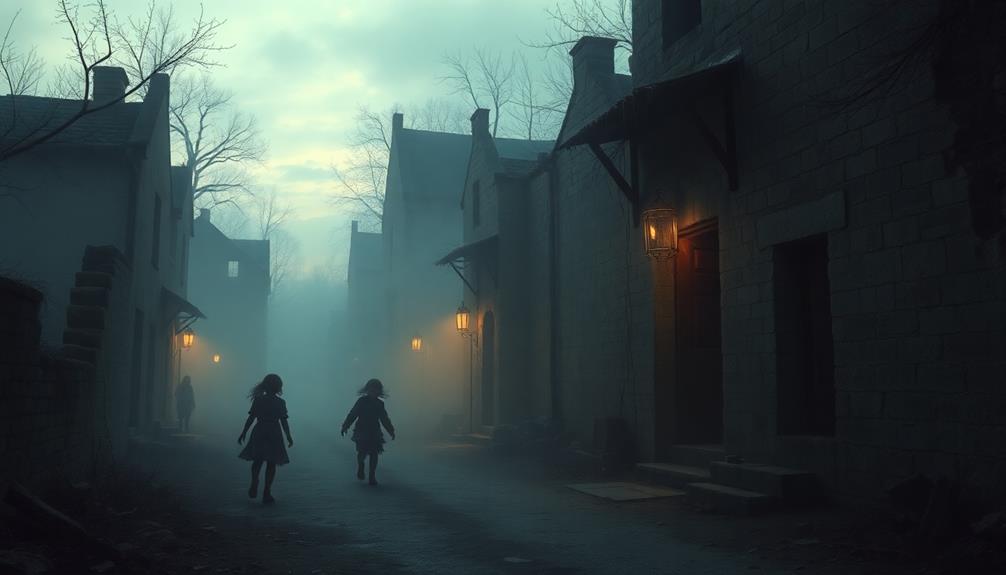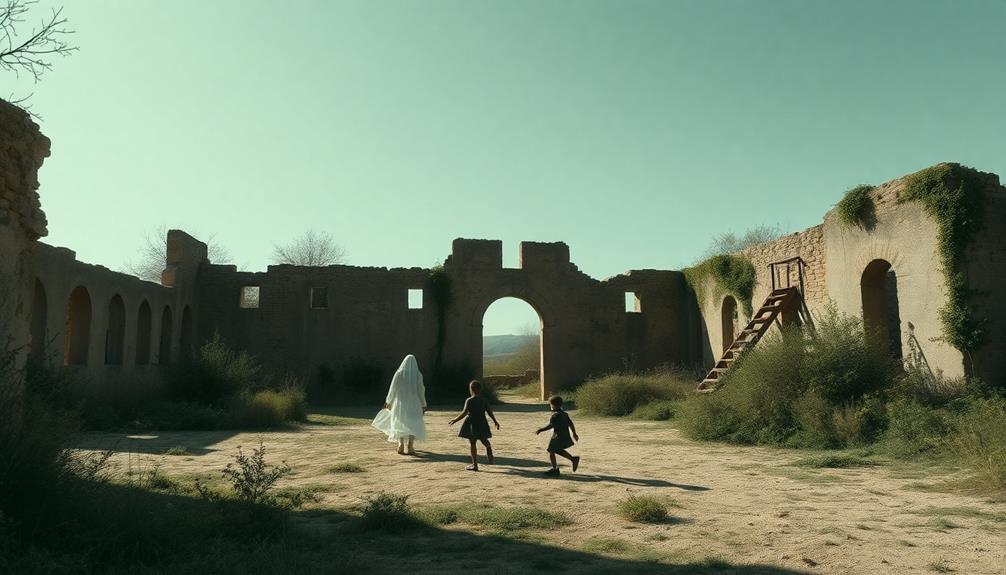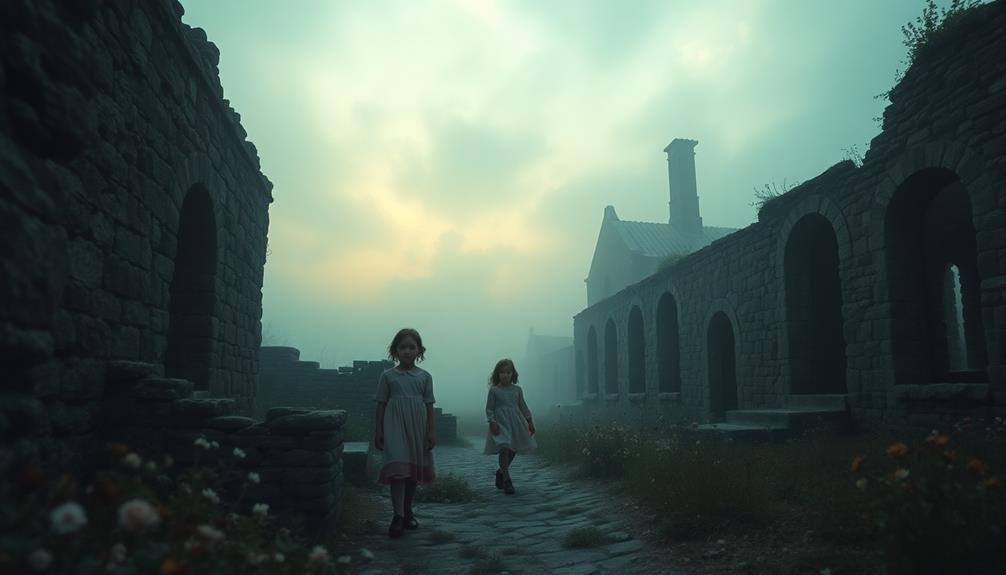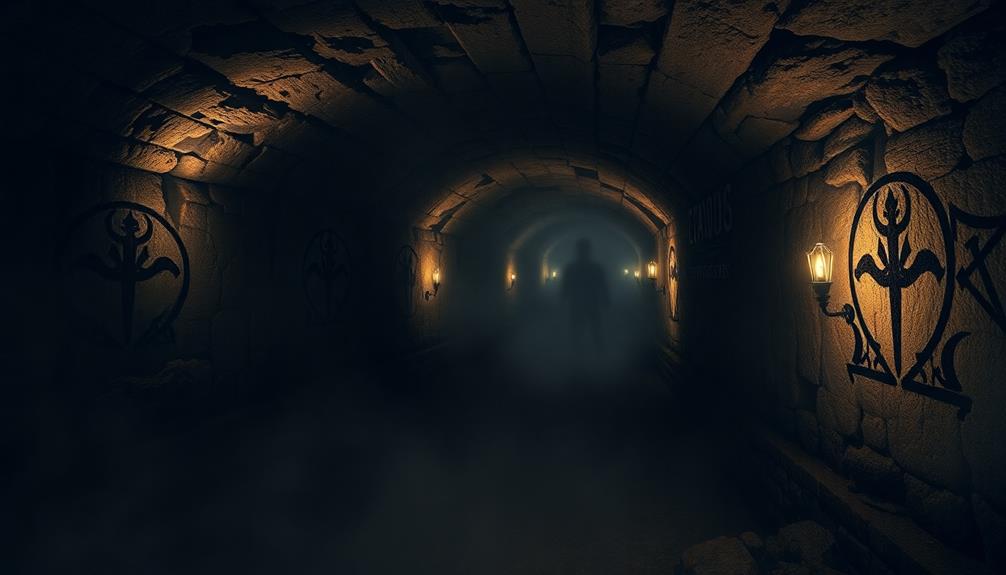In the haunting ruins of Belchite, you'll hear tales of ghostly children who never aged, forever trapped in the shadow of the Spanish Civil War. Many believe these spirits represent the tragic loss of innocence, as cries for their mothers echo through the desolate streets at dusk. Visitors often report seeing ghostly figures and experiencing chilling cold spots, enhancing the town's eerie reputation. Eyewitnesses describe how these spectral children seem frozen in time, seeking solace for their untimely deaths. The legends surrounding Belchite are enchanting, and you'll uncover even more chilling stories as you explore further.
Key Takeaways
- The ghost children of Belchite symbolize the tragic loss of innocence during the Spanish Civil War, with their spirits believed to remain youthful.
- Local folklore claims that cries for mothers can be heard at dusk, reinforcing the haunting presence of the ghost children in the ruins.
- Eyewitnesses report eerie encounters, including children's laughter and sightings of ghostly figures, during ghost tours of Belchite.
- Paranormal investigations have captured audio of children's voices, supporting the legend that these spirits are forever trapped in time.
- The haunting imagery of ghost children reflects historical trauma, connecting past grief with contemporary cultural narratives about the Spanish Civil War.
Historical Background of Belchite

What makes Belchite a significant site in Spanish history? Established as a fortress commune in 1118, this town in Aragon carries the weight of its past, especially marked by the ruins left from the Spanish Civil War.
The Battle of Belchite, fought from August 24 to September 7, 1937, witnessed intense fighting between Republican and Nationalist forces. The devastation was immense, with an estimated 5,000 lives lost, including many civilians. Following the battle, dictator Franco ordered the original Belchite to remain in ruins as a grim memorial, symbolizing the horrors of the war.
Afterward, a new Belchite was constructed nearby to house the displaced residents, but the ruins of the original town stand as a poignant reminder of the conflict.
The remnants of churches and a monastery, now in various states of decay, reflect the architectural grandeur that once was, while serving as focal points for ongoing preservation efforts. You can walk through these ruins today, feeling the echoes of history and the pain that lingers in the air, providing a stark contrast to the new community that thrives nearby.
The Tragic Events of 1937

The Battle of Belchite from August 24 to September 7, 1937, stands as one of the most tragic chapters in the Spanish Civil War. During this two-week ordeal, the town transformed into a hellish battleground, witnessing the deaths of at least 5,000 individuals, both soldiers and civilians.
The intense shelling rendered Belchite almost unrecognizable, as buildings crumbled and lives shattered. You can imagine the horror faced by those trapped within the town, struggling without basic necessities like water.
After the Nationalist forces, led by Francisco Franco, captured Belchite, they left the town in ruins, choosing not to rebuild. This decision turned Belchite into one of the haunting ghost towns of Spain, a stark reminder of the brutal consequences of civil conflict.
The devastation was so profound that Franco ordered the abandoned ruins to remain untouched, serving as a chilling memorial to the horrors of war. As you walk through the remnants of Belchite today, the echoes of the past linger, reminding you of the tragic events that unfolded during that fateful summer in 1937.
The Legend of the Ghost Children

Amid the haunting ruins of Belchite, stories of spectral children have emerged, capturing the imagination of locals and visitors alike. The ghost children are said to wander the desolate streets, forever trapped in a state of eternal childhood, a heartbreaking reminder of the tragic loss during the Spanish Civil War. As dusk falls, local folklore suggests you might hear their cries for their mothers, echoing through the eerie silence.
| Aspect | Details |
|---|---|
| Event | Battle of Belchite |
| Victims | Many young children |
| Eerie Manifestations | Sightings and sounds reported by visitors |
| Symbol of Innocence | The ghost children symbolize lost innocence |
The presence of these ghost children adds to Belchite's reputation as one of Spain's most haunted locations. Visitors often leave with chilling stories, claiming to have captured images and sounds of these lost souls during ghost tours. The legend of the ghost children serves as a poignant reminder of the innocence lost in the ravages of war, forever lingering in the shadows of Belchite.
Eyewitness Accounts and Experiences

Many who've ventured into the ghost town of Belchite recount spine-chilling experiences that blur the line between reality and the supernatural. You might hear the eerie cries of children echoing through the abandoned streets, their voices seeming to search for their mothers.
Witnesses often describe ghostly figures resembling children playing among the ruins, trapped in a loop of eternal childhood. As you explore the remnants of this haunting town, you could encounter cold spots that send shivers down your spine, accompanied by unexplained laughter that lingers in the air.
Many visitors document these unsettling sensations, adding to the town's eerie reputation. Paranormal investigations have captured audio recordings of children's voices calling out for help, expressing sadness tied to their tragic fates during the war.
Local legends suggest that the spirits of the ghost children of Belchite remain forever youthful, a poignant reminder of the innocence lost amid the violence of the Spanish Civil War.
It's these chilling accounts and experiences that draw thrill-seekers and history buffs alike, leaving you to wonder about the true nature of the spirits that haunt this desolate place.
Haunting Phenomena in Belchite

Unease fills the air in Belchite, where haunting phenomena weave a tapestry of sorrow and loss. As dusk settles, you might hear the eerie cries of children echoing through the abandoned streets, believed to be the spirits of those who lost their lives during the Spanish Civil War.
Eyewitness accounts describe ghostly children playing among the ruins, their laughter mingling with the lingering sorrow of the past. These apparitions appear frozen in time, never aging, as if trapped in a world they can't leave behind.
Paranormal investigators flock to this haunted site, often recording unexplained sounds and voices that seem to call out from the shadows. Many locals share legends suggesting that these spirits seek solace or recognition for their untimely deaths, reminding us of the tragedy that unfolded here.
The haunting phenomena in Belchite have solidified its status as one of Spain's most haunted locations, drawing ghost hunters and curious tourists alike. As you walk through the remnants of this once-thriving town, the weight of its history becomes palpable, leaving you to ponder the fates of those ghostly children who still linger in the twilight.
Preservation of the Ruins

When you explore the ruins of Belchite, you can't help but appreciate the importance of preserving its historical significance.
Restoration efforts face challenges, but community involvement and support play a crucial role in ensuring that these remnants of the past endure.
Importance of Historical Preservation
Preserving the ruins of Belchite is vital for honoring the memories of those affected by the Spanish Civil War. These remnants stand as a powerful symbol of the conflict's devastation and the lives lost.
Through various preservation initiatives, local governments and historical societies work together to guarantee that the haunting legacy of Belchite remains accessible for generations to come.
Here are three key reasons why historical preservation is important:
- Cultural Significance: The architectural remnants, like the Church of San Martin de Tours and the 18th-century monastery, reflect Belchite's rich history and cultural identity.
- Educational Opportunities: Guided tours of the ruins not only educate visitors about the events of the Spanish Civil War but also highlight the importance of preserving such historical sites against natural decay.
- Community Commitment: With funding like the $120,000 pledged for repairs, the community demonstrates its dedication to maintaining Belchite as a monument to historical memory.
Restoration Efforts and Challenges
The importance of historical preservation in Belchite is evident in the ongoing restoration efforts aimed at its iconic ruins. These efforts focus on significant structures like the Church of San Martin de Tours and the Church of San Agustin, showcasing the architectural impact of the Spanish Civil War. The local government, along with historical societies, commits around $120,000 for repairs, particularly to address damage from recent film productions.
| Challenge | Description |
|---|---|
| Funding Limitations | Limited financial resources hinder extensive restorations. |
| Structural Instability | Many buildings face instability, complicating preservation. |
| Expertise Requirements | Skilled professionals are necessary for addressing war-damaged architecture. |
| Visitor Management | Balancing tourism with conservation is critical to maintain integrity. |
Ongoing preservation initiatives are essential to protect Belchite's ruins from natural decay while enhancing educational opportunities about the town's historical significance. However, the challenges in these restoration efforts require innovative solutions to guarantee these remnants of history endure for future generations.
Community Involvement and Support
In Belchite, community involvement plays an essential role in preserving the town's ruins and ensuring their historical significance remains intact. The local government collaborates with historical societies to implement preservation initiatives that protect these important sites from natural decay.
By fostering a sense of pride in their heritage, the community actively participates in several initiatives, including:
- Guided Tours: These tours educate visitors about Belchite's rich history while generating revenue for restoration efforts.
- Fundraising Events: Local festivals and events raise awareness and support for preservation, engaging residents and tourists alike.
- Film Revenue Allocation: A portion of the earnings from film productions, like commercials featuring celebrities, goes directly to repairing deteriorating structures.
This collective effort not only nurtures a deep connection to the past but also encourages investment in preservation projects.
The haunting reputation of Belchite continues to attract tourists, further enhancing community engagement. With each initiative, you're not just participating in a project; you're safeguarding the town's legacy for future generations, ensuring that the ghost children of Belchite and their stories remain alive and well.
Impact on Modern Tourism

Belchite's haunting allure, especially the legends of ghost children crying for their mothers, captivates tourists and has turned the town into a thriving hub for ghost tours and paranormal investigations. Each year, thousands flock to explore the eerie ruins, drawn by stories that blend history and the supernatural.
Local tourism initiatives enhance this experience with guided tours that investigate the tragic past, allowing visitors to connect with the site's history and the ghost children's tales.
Film productions, from documentaries to commercials, have further elevated Belchite's profile, bolstering its status as a prime destination for those interested in the paranormal. This attention has sparked a significant increase in heritage tourism; people are keen to learn about the Spanish Civil War while immersing themselves in the chilling folklore surrounding the ghost children.
The economic impact on local businesses is undeniable. Accommodations and shops now cater specifically to tourists interested in these haunting legends, creating a vibrant economy that thrives on the intersection of history and tourism.
Through ghostly tales, Belchite has transformed its past into a profitable present, ensuring that the stories of the ghost children will continue to resonate.
Cultural Representations and Influence

When you explore the haunting imagery of the ghost children in cinema, you'll notice how these representations shape our understanding of historical trauma.
They reflect the deep scars left by the Spanish Civil War, reminding us of the innocence lost amid chaos.
This cultural influence not only preserves memory but also invites a dialogue about the impacts of conflict on society.
Haunting Imagery in Cinema
Haunting imagery in cinema often evokes powerful emotions, especially when it comes to the portrayal of ghost children. Films like Guillermo del Toro's "The Devil's Backbone" and "Pan's Labyrinth" utilize the backdrop of Belchite to explore themes of innocence lost amid the chaos of war.
These ghost children symbolize the unresolved trauma of the Spanish Civil War, reminding you of the pain etched in history.
Here are three key elements that make this imagery so impactful:
- Visual Representation: Ghost children are often depicted with somber expressions and tattered clothing, amplifying their role as symbols of lost innocence.
- Cultural Fears: Their presence taps into societal fears and memories, connecting audiences to deeper emotional experiences linked to historical tragedies.
- Atmospheric Significance: The eerie ruins of Belchite serve as a haunting backdrop, making the ghostly apparitions more evocative and memorable.
As these films continue to resonate, they embed the haunting imagery of ghost children into popular culture, ensuring that the legacy of Belchite remains alive in our collective memory.
Historical Trauma and Memory
The legacy of ghost children in cinema reflects a deeper narrative about historical trauma and memory that resonates beyond the screen. These spectral figures symbolize the profound loss experienced during the Spanish Civil War, where thousands perished, including many innocent children. The haunting cries of these ghost children echo the unresolved grief that permeates Spanish society, reminding you of the fragility of innocence.
Through cultural representations, filmmakers like Guillermo del Toro reveal how historical trauma shapes collective memory. His exploration of ghost children serves as a metaphor for the lingering effects of war on future generations. The concept of hauntology becomes tangible in Belchite, where the memories of lost children manifest through apparitions, linking the past to the present.
| Element | Symbolism | Cultural Impact |
|---|---|---|
| Ghost Children | Innocence lost | Reflection on trauma |
| Cinema Representation | Haunting narratives | Emotional connection |
| Local Legends | Memory and folklore | Identity as remembrance |
| Psychological Effects | Unresolved grief | Healing through storytelling |
As you engage with these stories, you contribute to the ongoing dialogue about memory, loss, and the enduring impact of historical trauma.
Conclusion
In exploring the haunting legend of the ghost children of Belchite, you can't help but wonder if their eternal youth symbolizes the unresolved trauma of a community scarred by war. Some believe these apparitions serve as a poignant reminder of the past, urging visitors to confront history rather than bury it. Whether you see them as mere folklore or a reflection of real sorrow, their story compels you to acknowledge the weight of memory in shaping our present.










